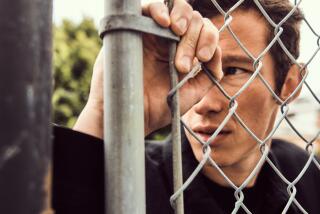PBS Finally to Air ‘Building Bombs’ : Television: Controversial show about the fallout from building hydrogen bombs has been delayed for years--and edited-- but basic points remain, producer says.
After three years, a lobbying campaign involving Hollywood celebrities and a bitter public debate between the producers and public-television executives, the documentary “Building Bombs” is finally coming to PBS tonight.
With its images of concrete floors turned spongy by years of radiation exposure, of sad-eyed radioactive turtles loose in the wilderness and nuclear waste buried in cardboard boxes in shallow ditches, “Building Bombs” shows what has happened during a 40-year period at Savannah River Plant in South Carolina, where hydrogen bombs were made and where the film says there are now “more cancers, more health problems.”
In West Hollywood, the Coalition vs. PBS Censorship, organized by co-producer Mark Mori last year to help get “Bombs” aired, is throwing a “victory” party tonight to coincide with its broadcast on KCET-TV Channel 28 at 10 p.m. (and at 9 p.m. on KPBS-TV Channel 15) as part of the “P.O.V.” (Point of View) series.
But at least for Mori, who produced the film with Susan Robinson, victory appears to have a hollow edge.
*
The PBS version, retitled “Building Bombs: The Legacy,” is 10 minutes shorter than the original film. At 44 minutes, it focuses almost exclusively on the environmental impact of the nuclear weapons plant--”the bitter fruit of nuclear supremacy”--while de-emphasizing the exploration of the reasons for the nuclear buildup that had been subtext in the original.
Although whistle-blower William Lawless, former chief of radioactive waste management for the Department of Energy at the site, is still the central character, gone is physicist Arthur Dexter, who estimated after seeing the super-secret containers of tritium at Savannah River that the nation’s stockpile had grown to 30,000 hydrogen bombs.
There is new narration and a new narrator--Susan Clark of the old “Webster” series, an activist against nuclear waste. She replaced Jane Alexander, nominated Saturday by President Clinton to head the National Endowment for the Arts, who had to decline re-narrating because she was busy on Broadway in “The Sisters Rosensweig.” (Through a spokesman last week, Alexander, who had been active in Women’s Action for Nuclear Disarmament, said she was “very respectful and admiring of that (original) piece.”)
It has been a long, arduous, befuddling journey to broadcast on PBS.
In September, 1990, PBS rejected the film as a “stand-alone special” for reasons of content. Glenn Dixon, then PBS’ director of news and public-affairs programming, wrote Mori: “ ‘Building Bombs’ does not give adequate voice to those who are proponents of nuclear arms.”
“Building Bombs” went on to be nominated for an Academy Award as best feature documentary for 1990. But Oscars simply honor “artistic merit,” Jennifer Lawson, executive vice president for national programming at PBS, wrote in a Counterpunch article for The Times last February; PBS’ editorial standards are something else. She argued that, in terms of balance and quality, the documentary just wasn’t up to snuff.
Mori maintained that PBS’ real concern was “fear of offending nuclear interests.”
Despite Dixon’s complaint, the original “Bombs” contained such segments as Fred Christensen, a retired engineer for DuPont, which had the government contract to build and run Savannah River, repeating the “better dead than Red” argument; and James Edwards, secretary of energy under President Ronald Reagan, declaring that “if . . . the Soviet Union had pressed the (nuclear) button, wouldn’t it be nice to know we had some to press the button back?” These scenes are now out.
Mori contends that it was pressure by the entertainment community--including a full-page ad last January in Variety, signed by a host of celebrities including Alexander, David Geffen, Woody Harrelson, Jack Lemmon, Edward James Olmos and Oliver Stone--that led PBS to change its mind about broadcasting the film.
PBS denies that pressure played a role. “I think it is PBS’ willingness to broadcast the revised version in spite of Mark Mori’s efforts to label this as censorship,” Lawson said in an interview, “(that) points to our interest in not responding to special-interest groups or producers.”
She insists that the changes to “Building Bombs” make the original “a different film from the one that has now been accepted by ‘P.O.V.,’ ” eliminating “a substantial earlier portion about the Cold War and the buildup of nuclear arms (and) some allegations that seem quite dated in light of the end of the Cold War. (This) program is more focused, in our view, because it concentrates much more on the legacy of nuclear waste.”
Both Lawson and Ellen Schneider, executive producer of “P.O.V.,” praised the filmmakers for making changes. Now in its sixth season, “P.O.V.” was designed to give voice to documentary filmmakers who might not otherwise have access to PBS.
Mori has mixed feelings. He got his way by not having to re-shoot, the bulk of the material is in there, and he believes the new narration makes the film stronger. He says that he’s happy it’s finally getting on the air but that he would have been happier if it had been aired when first submitted.
“I think it’s crazy to want to remove all those Cold War references,” he said, “because we haven’t fully reckoned with this Cold War business, and it’s important history.”
Yet he cut. “I felt if this was the only way I’m going to get at least the most important part of the story (on the air), then I’ll go for that.”
Robinson agreed. It was a “heartbreaker to cut Dexter,” she said, “(but) my philosophy is ‘reform, not revolution’ . . . so although the ‘new and improved’ (film) is not the original version in all of its richness, I see this airing as a tremendous opportunity to bring the core issues . . . to the public.”
*
Listening to Lawson and Schneider, it’s almost as if public television were speaking with two voices.
Schneider recalls that when “Building Bombs” was originally submitted to “P.O.V.” in September, 1990, “there was no dispute with the original version (at “P.O.V.”).” Then a co-producer on the series, she says it didn’t air because it was “similar in content” to “Dark Circle,” a 1982 film about the nuclear facility at Rocky Flats, Colo. Shunned for years by PBS, “Dark Circle” finally aired in August, 1989. Still, “Bombs” would have aired two years later.
After being rejected by PBS, “Building Bombs” found a home in cable. In August, 1992, a 45-minute version, with parts of Dexter still in, aired on the Discovery channel. In September, when the filmmakers reapplied to get it on “P.O.V.,” Schneider said she was more interested in the Discovery version than the original.
“It seemed an excellent example of investigative work that is fact-driven and issue-specific,” she said, “and when I showed it to an advisory committee, they asked if it would be possible to be updated because the original film was completed in 1989.”
Meanwhile, Mori ruminates about what wound up on the cutting-room floor. It bothers him to know that to fill up its hourlong time slot, “P.O.V.” had to schedule a little piece called “Over the Hedge.” It’s about the artistry of pruning shrubbery.
More to Read
The complete guide to home viewing
Get Screen Gab for everything about the TV shows and streaming movies everyone’s talking about.
You may occasionally receive promotional content from the Los Angeles Times.






